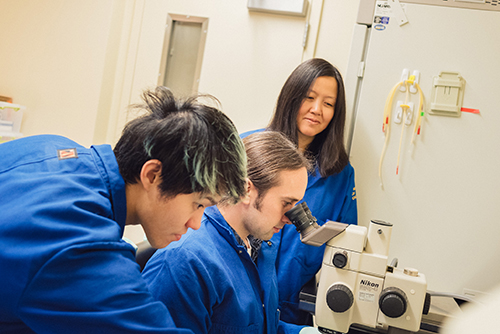
Lin He
Molecular and Cell BiologyLin He is a Professor in the Department of Molecular and Cell Biology.
Project Description
Highly Efficient Mammalian Genome Editing by CRISPR RNP Electroporation of Zygotes
Today, standard CRISPR-editing practice in mice involves microinjection of Cas9 DNA/mRNA into zygotes to directly generate modified animals. While a significant improvement over previous genome engineering methods, microinjection is a costly and time-consuming procedure. We have developed a novel electroporation-based strategy, CRISPR-EZ, to deliver preassembled Cas9 ribonucleoproteins (RNPs) for genome editing. This method enables high-efficiency and high-throughput genome editing in vivo with an optimal embryo survival rate at a fraction of the cost of microinjection-based methods. We propose to further increase the overall editing efficiency of CRISPR-EZ, and to enable more complex genome engineering schemes in mice. In collaboration with experts in animal reproduction biology, we propose to expand the utility of CRISPR-EZ to engineer the genomes of other mammalian species. Given the advantages of CRISPR-EZ technology in editing efficiency and embryo survival, it has considerable potential to be the preferred CRISPR genome editing technology in mammals.
Lin He’s Story
Science magazine dubbed it the CRISPR craze. It’s been a quick five years since Berkeley scientists first proposed that a system called CRISPR/Cas9 could greatly improve the efficiency of gene editing. Biomedical and industry researchers around the world quickly adopted the method to study disease, test drugs, boost crop yields and improve animal breeding.

Derived from a strategy bacteria use to disarm invading viruses, CRISPR enables researchers to cut and paste stretches of DNA in organisms much more quickly and with greater precision than previous genome editing techniques. It supplanted its predecessors almost overnight.
But even a good technology can still have limitations. Researchers normally use thin pipettes to “microinject” the CRISPR machinery into an embryo. But the microinjection procedure is painstaking. It limits the pace of engineering genomes. It requires more manpower and is expensive, and the success rate is low.
Lin He’s lab uses CRISPR technology to study how different genetic elements in a mouse embryo’s cell nucleus – genes that encode proteins, functional RNAs, and repetitive sequences – interact to assure normal development or trigger cancer.
Instead of microinjecting the CRISPR complex, He’s lab is developing a technique using electroporation, a procedure that applies an electrical field to the embryo to increase its permeability and improve delivery of CRISPR machineries. This approach, dubbed CRISPR-EZ, can be much faster, allowing “high throughput” – hundreds of times more CRISPR gene edits per hour. It is also more accurate, and promises to outpace the success rate current CRISPR techniques.
“It’s not yet trouble-free,” says He, an associate professor of cell and developmental biology. “But it’s really a big step forward.”
With support from the Bakar Fellows Program, He is perfecting the CRISPR-EZ technology she developed with graduate student Sean Chen and postdoctoral scientist Andrew Modzelewski. CRISPR-EZ has served her well for manipulating relatively short stretches of DNA or RNA, but her research now demands editing larger chunks of DNA in mouse embryos -– either the entire stretch of DNA that makes up a gene or the long sequences between genes. For this purpose, current CRISPR-EZ techniques are not yet efficient.
“To carry out our new research, we need to insert a large fragment of genetic sequence. We want to adapt electroporation-based CRISPR delivery for complex genome editing schemes. This is something we are very actively doing with the Bakar Program support.”

He aims to tease apart the molecular processes that generate pluripotent stem cells in the first few days of a mouse embryo’s life as it goes through its initial cell divisions. A few days later, the cells begin to specialize, allowing the embryo to develop the repertoire of tissues and organs it will need as an adult.
She also uses CRISPR gene editing to study how a single change in a DNA “letter,” – a change called a SNP – might trigger cancer. The research can reveal triggers for cancer and other human diseases.
As part of her research on mouse embryo genomics, He often examines stretches of DNA that lie between genes in search of “functional elements.” These don’t carry instructions to make new proteins as genes do, but many play an essential role in regulating development and disease. Non-protein coding DNA makes up more than 98 percent of the human genome, whose function is largely mysterious.
She is confident that the more efficient approach will be a boon to basic research as well as a strategy to boost the efficiency of livestock breeding and growing organs for transplant.
To determine how different genes affect disease vulnerability or progression, many researchers use “knockout” mice, with one specific gene deleted or inactivated. He says the electroporation technique has greatly accelerated her ability to carry out knockout experiments.
“In my first six or seven years at Berkeley, I knocked out three genes in mice. I can do close to a dozen in a year now.”
With greater speed, efficiency and cost savings come broader horizons.
“In the past, we limited our research goals to what the CRISPR technology would allow. Now the limitation will be our imaginations.”